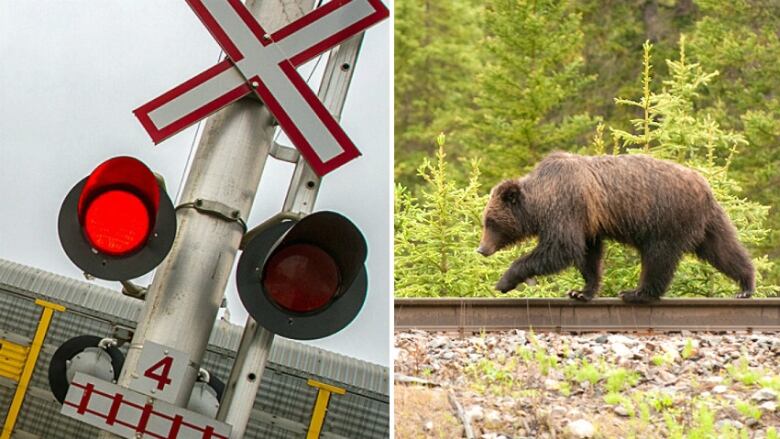Grizzly bears need better sightlines and signals along rail lines, 5-year study concludes
Parks Canada and CP Rail to take further steps to reduce chances of train-wildlife collisions

Imagine you're a grizzly bear in Banff, just trying to live your grizzly bear life, but you keeprunning into all those annoying tourists.
The most sensible response, of course, is to wait until they all go to bed to do your roaming around. And naturally, you decide to follow the train tracks, since it's the easiest path through all those dense trees.
Suddenly, a freight train comes 'round the bend, with its bright lights glaring, engine roaring and horn blaring.
What do you do? You panic.
- Grain spill found on train tracks in Calgary's Edworthy Park
- Grain spills on tracks killing Banff bears: wildlife group
At least, that's what lots of grizzlies do when they find themselves in that scary situation, according toColleen Cassady St. Clair,a University of Alberta biologist who directed a five-year study into train-wildlife collisions.
Bears and other animals often freeze in place when confronted with an oncoming freight train, she said, or they try to run in the opposite direction of the fast-approaching lights.
"But they can't outrun the train," she said.

Researchers tracked about a dozen bears between 2010 and 2015 using radio collars to find out when and where they went walking along the rail line.
The study, funded by CP Rail and Parks Canada, looked into the role that spilled grain from leaking rail cars plays in attracting bears onto the tracks, but the results suggest that's just one among many factors that lead to grizzly fatalities.
St. Clair said the grizzlies frequent the rail line at the west end of Banff National Park more often, but there tend to be more fatalities in the east end.
"In the east end of the park, there is more human use near the rail, including near where many strikes have occurred," she said. "And bears seem to be more nocturnal in their use of the rail in that location, probably to avoid people."
That area is also near the noise of heavy trucks that use the Trans-Canada Highway at night, making it harder for bears to hear approaching trains, so walking along winding sections of that track in the dark can lead to sudden surprises for grizzlies.
"The cumulative effect in that location is confusion," St. Clair said. "And confusion is the thing that we think ultimately causes the mortality."
Possible solutions
The study concluded that giving grizzlies better travel paths and sightlines along rail lines is the best way to keep the bears safe from trains.
"We're actively going to be more involved in creating more trails for bears to be able to move past impediments on the railroad," said Rick Kubian withParks Canada.
"Those pinch points on the landscape where bears are forced to the railroad, we're looking at a few locations where we might be able to provide alternatives for bears so they don't have to travel that corridor."

Parks Canada also plans to use prescribed burns to create more areas of good bear grazing away from train tracks, Kubian said.
In addition, CP will spend $750,000 over three years to trim vegetationthat attracts bears near rail lines and open escape paths for them where trees and bush now block the way, said Joe van Humbeck, an environmental assessment manager with the company.
The company will also use electromats and fences around railroad lubrication stations, where bears sometimes enjoy a good lick of grease.
Crossing signals for bears
Both CP and Parks Canada are experimenting with flashing lights and sounding alarms in areas that bears are likely to use to give them more warning of approaching trains. A device is being tested in four locations.
"We are waiting to see the results," van Humbeck said. "The initial indications are quite positive."
St. Clair said it's possible the program could be expanded, targeting areas that are the most high-risk for collisions.
"We could install mitigation at those sites perhaps the devices we've invented, perhaps some other kinds of mitigation that wouldn't be practical to install along the whole track, partly because animals would habituate to it," she said.
"But if it's localized to the places where the danger actually is heightened, it could be very effective, just as train crossing signals are effective for humans, as drivers and as pedestrians."
Wildlife fatalities
The study began in 2010 after bear deaths along the CP line through Banff National Park grew to account for nearly one-third of all bear deaths in the park.
Van Humbeck said there hasn't been a confirmed grizzly death along the railroad since 2012.
Four wolves were killed last year after being hit by trains in Banff.
With files from the CBC's Colleen Underwood and the Canadian Press












_(720p).jpg)


 OFFICIAL HD MUSIC VIDEO.jpg)
.jpg)



























































































